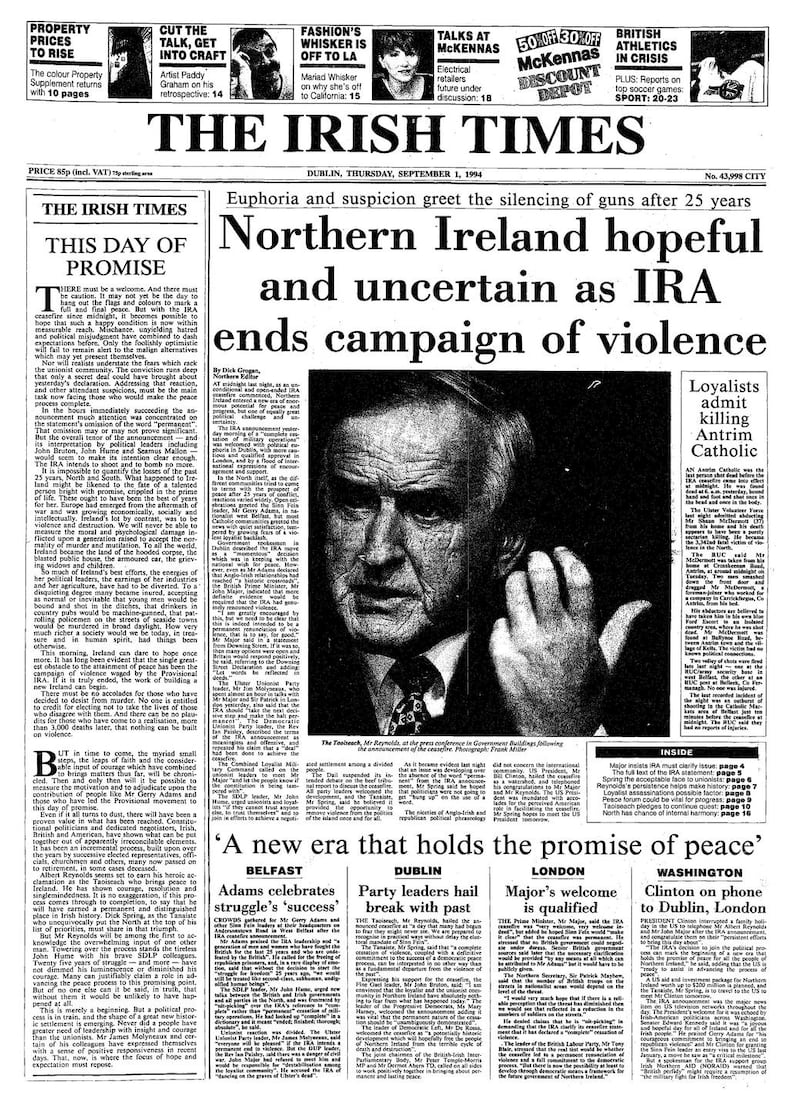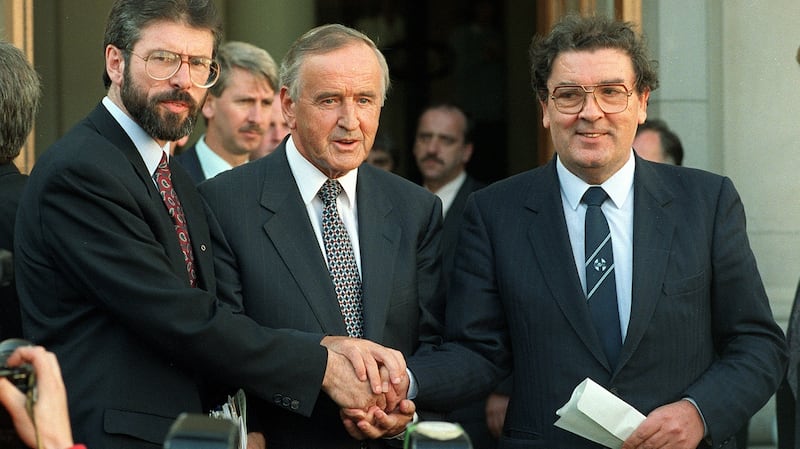The Provisional IRA called its ceasefire 25 years ago on this date (August 31st, 1994). There might be a memory that after more than 3,000 deaths, of many thousands more seriously injured and maimed and of almost daily violence that the announcement from P O’Neill of a “complete cessation of military operations” was universally celebrated with relief and joy.
It would be a false memory.
The late Dick Grogan, the then Northern editor of The Irish Times, was prescient in his analysis of the ceasefire published in the paper the following day.
He wrote, “Though there would have been time enough for the splitting of hairs, the process has already begun. The IRA ceasefire announcement used the word ‘complete’ instead of ‘permanent’.
“Thus, we are consigned to a semantic nightmare which may not be permanent but which will certainly never be completed to everyone’s satisfaction.”
And that’s what it became, a semantic nightmare.
In that same paper on September 1st John Hume, then leader of the SDLP and probably the politician chiefly responsible for making the ceasefire possible, called for an end to the "nit-picking". He appealed to the British and Irish governments and all the parties including Sinn Féin to enter into dialogue to find a way forward. Even on that day of some optimism you could sense the anguish and foreboding in his words.

You could detect too the frustration of the man who went out on a limb to help create peace, only to see right from the off that the dominant response from unionism and the British government was hope-draining negativity.
Another SDLP stalwart, the late Jonathan Stephenson, cited how the Collins National Dictionary defined “complete” as “entire, finished, perfect, with no part lacking”.
Ceasefire
No one was expecting gratitude to the IRA that after a quarter century of bloodshed pursuing its unachievable "Brits Out" policy. It finally cottoned on that, as an old Troubles maxim goes, you can't bomb a million Protestants into a united Ireland.
The black Northern joke that emerged shortly after that ceasefire made the same point. It asked what was the difference between the Provos and the Stickies (the Official IRA, who in 1969 decided that a paramilitary solution would not work?) The answer: 25 years.
You don’t thank people for not killing you.
But there was a perception that this was a chance for peace, and if it was not carefully managed it could be squandered. That was a real feeling among many people on the day the ceasefire was announced 25 years ago – that amid the subdued hope and the emotional release there was the fear it would all be blown apart through bad politics.
Again reading The Irish Times of September 1st you see Ian Paisley warning of the danger of Northern Ireland plummeting into civil war but in 1994 that's what you expected from the then DUP leader.
Paisley did make the valid point, however, that the cessation statement did not “contain one word of repentance or remorse for the past 25 years of violence, torture and terrorism which the IRA have inflicted upon the entire community”.
The Ulster Volunteer Force and Red Hand Commando, and the Ulster Defence Association were paying attention because six weeks later on October 13th when announcing their ceasefire they did express "abject and true remorse" to all "innocent victims" of the Troubles – although here it must be added that the loyalist paramilitaries have not totally gone away with many up to their necks in various forms of criminality.
One of the intriguing comments of that period came from the Ulster Unionist Party leader James Molyneaux, one that Gerry Adams has often referred to, most recently this week when delivering his recollection of the ceasefire. Molyneaux described the IRA cessation as one of the most "destabilising events since partition".
He didn’t really explain what he meant at the time, but in 2005 he told me that his comment was based on his suspicion that this was a republican trap to facilitate a united Ireland. What was on offer from republicans was “phoney” from the outset, Molyneaux believed. He also suspected that some senior British foreign office officials connived to assist this alleged plot.
“I would have got at that time, nearly every day, people – a lot of them elderly English peers – saying, ‘you must be very happy now that violence has been called off’. My reaction would have been, ‘Yes, but what price will be paid?’”
Response
Those who still see merit in such a response might argue that the IRA ending its “complete cessation” in February 1996 demonstrated how right he was. The republican movement’s policy seemed to be if it could not get to the negotiating table through a ceasefire then it would get there by returning to the bomb and the bullet, which no democratic society should have to tolerate.
It took until July 1997 and more than 30 additional deaths and many more injuries for the IRA to call another cessation – this time, to most intents and purposes a complete and permanent one, although there were aberrations.
Lessons had been learnt by then and the new British Labour government led by Tony Blair, together with the Irish government led by Bertie Ahern and the Northern parties apart from the DUP, were able, after protracted negotiations, to achieve the Belfast Agreement on Good Friday 1998.
Yet, even now, the prevailing sense is that had there been a more pragmatic and accommodating unionist and British government response 25 years ago – as Hume had pleaded for – that the peace and the powersharing politics might have been sealed in 1994 or shortly thereafter rather than four years later.
Efforts to get the IRA off the stage began secretly in 1988 with talks between John Hume and Gerry Adams. They faltered but resumed again in the early 1990s, helping create the conditions for the 1993 British-Irish Downing Street Declaration signed by British prime minister John Major and taoiseach Albert Reynolds.
The IRA tardiness on arms helped drive the DUP to the top of the political pile
It stated that the British government had “no selfish strategic or economic interest in Northern Ireland” which in turn meant – despite some Jesuitical wrangling over the absence of a comma between “selfish” and “strategic” – that if the British had no such interest then the IRA was waging a sectarian war, not against the Brits, but against the Protestant-unionist people of Northern Ireland. And unionists, so provisional republicans said, were fellow Irish people.
Adams and Martin McGuinness faced up to that dilemma by finally, against resistance, getting the IRA to its August 31st ceasefire. That move led to a splintering rather than a splitting of the republican movement – most sided with Adams and McGuinness – and the creation of the subsequent alphabet soup of dissident organisations such as the Real IRA, Republican Action Against Drugs, Oglaigh na hÉireann, and the New IRA. The Continuity IRA already was in existence at that time.
Still the IRA doves prevailed over the hawks notwithstanding that the island is continuing to deal with the dissident threat. Moreover, that ceasefire helped propel Sinn Féin to becoming the dominant nationalist party, eclipsing the SDLP – another price Hume was prepared to pay to cement the peace, even if many in his party weren’t.
As a former IRA chief of staff from the early 1970s, John Kelly was wont to say, "It wasn't the IRA war that brought Sinn Féin success, it was the IRA peace."
International dimension
There was an international dimension to that ceasefire as well. Then US president Bill Clinton, under pressure from Hume, played his part in January 1994 by granting Adams a visa to visit the US, a move that appeared to infuriate the British government but pleased the republican base, helping soften it for the cessation decision eight months later.
The subsequent 1997 ceasefire paved the path to the Belfast Agreement the following year. That led to the Northern Executive and Assembly but it was a stop-start administration, in large part due to the IRA refusal, so to speak, to bite the bullet on decommissioning. The IRA tardiness on arms helped drive the DUP to the top of the political pile. Decommissioning finally happened in 2005, but by that stage the middle ground was usurped and Ian Paisley and the DUP had stolen the unionist crown from David Trimble and the Ulster Unionist Party, as Sinn Féin stole the nationalist crown from the SDLP.

Gerry Adams and Martin McGuinness had to do business with Paisley and Peter Robinson which, rather incredibly, they did with Stormont restored in 2007 and, more or less, lasting to the crash of January 2017. Sinn Féin, however, isn't doing any business currently with the DUP.
Northern Ireland has come a long way since 1994 but, as is evident from the hostility between the DUP and Sinn Féin and the continuing political paralysis, there are still great tests ahead. These include reinstating Stormont, Brexit, and the united Ireland debate that must be addressed with wisdom and sensitivity.
But as major as Brexit and the other problems are, what Northern Ireland politicians face today surely can’t be compared to the life or death challenges of 25 years ago. They have a great chance to restore Stormont now but because of more nit-picking can’t seem to take it.
The 1994 IRA cessation was hard won and too easily lost. Now there is concern that the equally hard won and too brief unionist-nationalist rapprochement, achieved through the large personalities of Paisley and McGuinness, could be completely or permanently jettisoned just as readily.
Looking back from today, perhaps such was the suspicion, hostility, polarisation and mistrust in August 1994 – not to mention the trauma that tens of thousands of people were suffering as a result of 25 years of violence – that London and unionism in particular were incapable of politically seizing the opportunity afforded by the IRA ceasefire. Yet even a quarter of a century on the sad sense of a big historic chance wasted still lingers.









